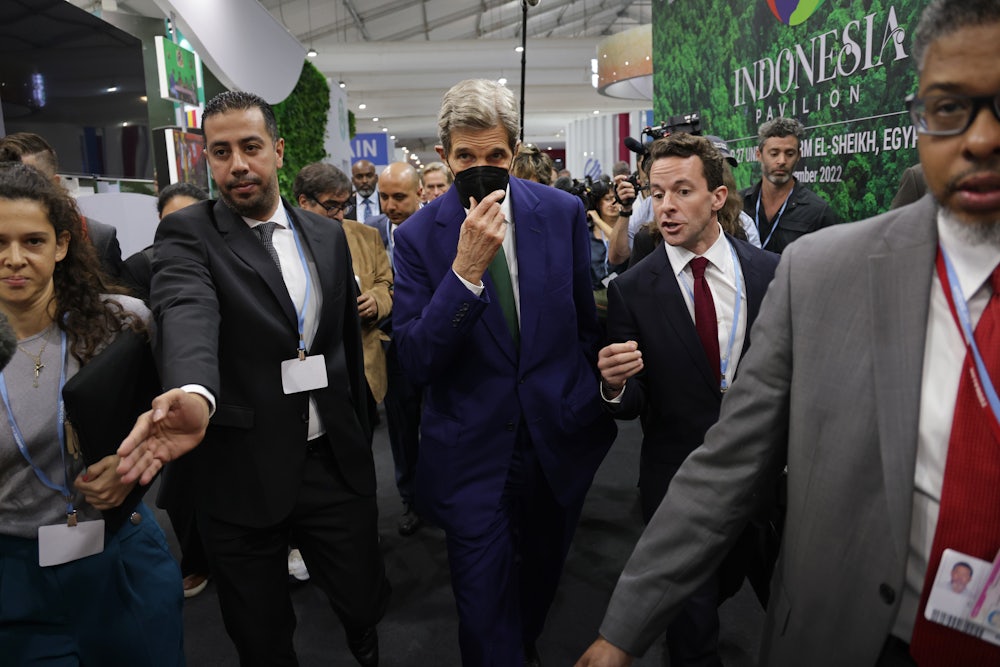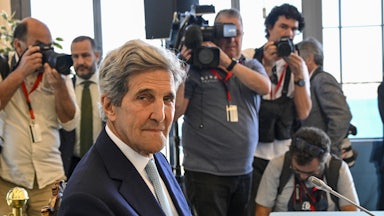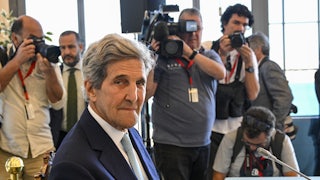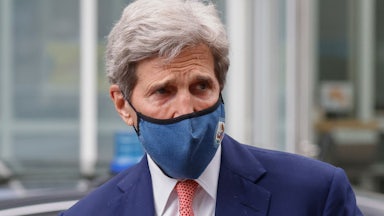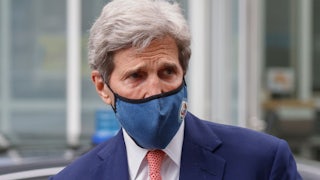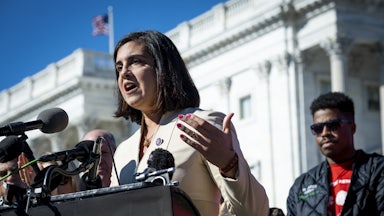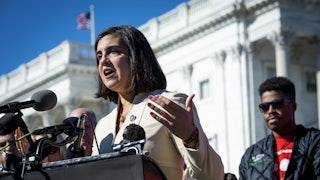As climate talks kicked off in Egypt this week and U.S. Democrats braced for a possible shellacking in Tuesday’s elections, climate envoy John Kerry floated a new initiative for helping countries finance emissions reductions. Hauling out a favorite line, Kerry told The Wall Street Journal that “no government in the world has enough money to affect the transition,” referencing the $1.3 trillion in annual funding developing countries have demanded richer ones furnish by 2030. “The entity that could help the most,” Kerry added, “is the private sector with the right structure.” And the structure Kerry wants to build involves enticing governments and corporations to buy so-called carbon credits, with the funds from those sales financing clean energy in developing countries. Details of the new framework are still scant, with more due to be announced tomorrow.
The private sector–led approach to climate policy hasn’t fared well over the last year. Voluntary private-sector pledges announced in 2021 have been watered down and criticized for claiming false progress toward net-zero emissions. Carbon offsets—a business this new U.S. plan seems poised to grow—have been especially controversial; numerous stories and studies over the past several years have suggested they may be worse than useless, plagued by accounting problems while essentially giving companies a green light to keep emitting. As the developing world’s demands for wealthy countries to deliver climate finance grow louder than ever at COP27, the market-driven plan Kerry and other U.S. officials are endorsing looks a lot like a distraction from the issue at hand.
“As it stands, based on the sparse details available, Kerry’s proposal does not appear to be a good idea,” said Khaled Diab of the Brussels-based watchdog group Carbon Markets Watch. This scheme, he added, “could potentially provide large corporations with a license to continue to pollute with impunity while making questionable net-zero claims. That means it could fling the doors wide open for large-scale greenwashing.”
Funding for renewable energy has already been excluded from voluntary carbon market standards that oversee how companies buy up credits to offset their own emissions. Offsets are a major way that corporations intend to make good on pledges for carbon neutrality and to reach “net-zero.” If they can’t reduce their own emissions, they can pay for reductions elsewhere.
To be effective, carbon credits must demonstrate something called “additionality,” i.e., that companies are paying for emissions reductions that wouldn’t happen otherwise. But claims of additionality have frequently been debunked. Most infamously, companies have bought up tracts of forests and made money selling offsets by simply promising not to start logging: an implicit threat. “It’s a hypothetical counterfactual of what the world would have looked like if that project had not been financed,” explains Jessica Green, a political scientist at the University of Toronto whose research focuses on climate policy, including carbon markets.
Determinations on whether additionality claims are real or fake, Green adds, are made by a series of third-party verifiers that make money from the firms developing projects they decide are legitimate or not. In the worst-case scenario, polluting entities buy themselves more time to keep emitting as usual with credits that aren’t reducing emissions at all. One analysis from Australia, released this week and reported by The Guardian, found that total tree and shrub cover actually decreased in an area meant to have been protected by millions of dollars’ worth of carbon credits purchased through Australia’s carbon credit system.
“It’s very hard to say what a ton [of carbon] is and should be. There’s a big difference between not emitting and removing a ton from the atmosphere, or not cutting down a tree for a period of time. Those are not comparable activities,” said Danny Cullenward, policy director at CarbonPlan, a nonprofit that analyzes carbon offsetting and removal. “These markets produce a single thing: a credit that represents a ton. And they’re not at all fungible, physically or conceptually.” Any prospective benefits are judged against what he calls an “unobservable counterfactual baseline.”
There is an existing U.N. fund through which governments are meant to finance mitigation projects—the Green Climate Fund—but the effort Kerry announced would be governed separately. An “independent, as-yet unspecified, accreditation body,” per the Financial Times, will reportedly certify the integrity of credits bought and sold under the framework.
The problem can be even worse than just not reducing emissions by as much as credit buyers or project developers claim. The question of “double counting” has dogged carbon offsetting schemes for as long as they’ve existed, Cullenward added. If a private company based in the United States buys offsets to preserve a forest in Brazil, for instance, then who gets the credit for those reductions? With such scant regulations, all three parties—the company, the U.S., and Brazil—could potentially claim to have “reduced” emissions by not logging the forest. Even if that forest really would have been logged, and therefore the carbon credits can demonstrate legitimate additionality, the carbon savings of that project could still be overstated by three times, with three separate entities counting the same chunk of avoided emissions toward their climate goals. The danger, critics argue, is that these potentially fake reductions will be used to take the place of actual cuts from governments and corporations alike. After all, it’s a lot easier to buy carbon credits than to decommission a coal plant that’s still making money.
The fact that carbon markets are so complicated helps to explain why the rules that govern them have gotten so little attention. Article 6 of the Paris Agreement deals with international cooperation on emissions reductions, with just one subsection (6.8) dedicated to “non-market” mechanisms to make that happen. The rest deals with carbon markets, from the bilateral and multilateral agreements between governments covered under section 6.2 to the voluntary carbon market—the kinds of offsetting described above—handled in section 6.4.
An implementation rule book finalized last year in Glasgow sets up a framework for trading credits known as internationally transferred mitigation outcomes, or ITMOs, meant to correct for persistent problems in existing carbon markets. Technical details still have to be worked out, though, and protections against double counting apply only to deals struck between governments—not to offsets bought by companies through the voluntary carbon market. Article 6.4 is intended to set global standards for credits traded there, but the Supervisory Body it established on carbon markets has come under fire this week for proposing lax standards as to which credits will receive U.N. backing.
The dangers of carbon trading being used for greenwashing was raised by an official U.N. body this week too. A U.N. high-level expert group released a report calling for a crackdown on watery, often offset-focused net-zero claims by nonstate actors, including corporations and local and regional governments. “Non-state actors cannot buy cheap credits that often lack integrity instead of immediately cutting their own emissions across their value chain,” the report recommended, suggesting that nonstate actors “move from voluntary initiatives to regulated requirements for net zero.”
The plan Kerry has proposed is a clear stand-in for something else: adequate financial commitments from rich countries like the U.S. to poorer countries at particular risk from climate-related disasters. That includes financing for loss and damage from such disasters—disasters the U.S., among others, is arguably more responsible for given its historic emissions. A number of rich countries (Austria, Scotland, Belgium, Denmark, and Germany) have recently announced modest financial commitments toward a loss and damage financing facility that does not yet exist—in part thanks to U.S. obstruction. In Egypt, Barbados Prime Minister Mia Mottley re-upped her call for a Climate Mitigation Trust, funded through a $500 billion issuance by the International Monetary Fund of Special Drawing Rights, a reserve currency controlled by the fund. The G77 countries and China—which represents developing countries in the UNFCCC process—“is united in its demand for establishment of a dedicated finance facility to provide new and additional financial support to developing countries for addressing loss and damage associated with the adverse impacts of climate change,” said Pakistan’s U.N. Ambassador Munir Akram, the bloc’s current chair.
A new carbon trading scheme would be a poor substitute for the kind of climate finance these parties are calling for, which a new U.N.-backed report suggests should be at least $2 trillion per year by 2030. A 2009 pledge for rich countries to provide $100 billion in annual climate finance to poor countries has yet to be met.
